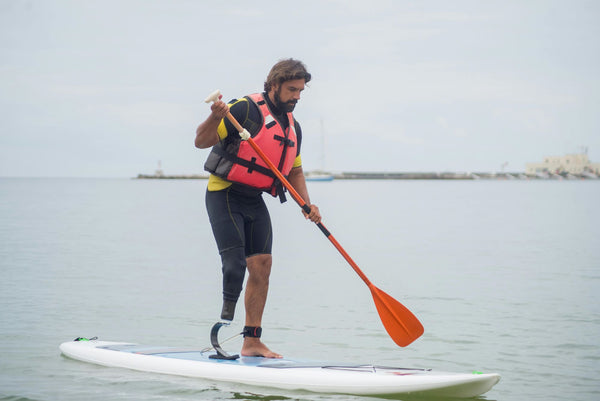12 Tips for Choosing the Right SUP Board
Are you ready to dive into the exhilarating world of stand-up paddleboarding (SUP Board)? Whether you're a seasoned pro or a curious beginner, finding the perfect board can make all the difference in your paddling adventures. But with so many options to choose from, where do you start? Fear not, adventurers! We've compiled a comprehensive guide featuring 12 Tips for Choosing the Right SUP Board to help you navigate the waters and find your perfect match.
From understanding different types of SUP boards to evaluating length, width, and thickness, we'll cover everything you need to know to make an informed decision. Plus, we'll delve into lesser-known factors like construction material, fin setup, and deck pad traction to ensure you find a board that suits your style and preferences.
So grab your paddle and join us as we embark on a journey to find the ultimate SUP board that will elevate your paddling experience to new heights. With our expert tips and insider advice, you'll be riding the waves with confidence and style in no time. Let the adventure begin!

1. Understand Different Types of SUP Boards
When it comes to navigating the vast ocean of stand-up paddleboarding (SUP Boards), understanding the different types is key to finding your perfect match. From all-around cruisers like the NSP ELEMENTS ALLROUNDER to adrenaline-pumping racers like NSP PUMA 14'0" PRO CARBON, there's a SUP board to suit every paddler's needs and preferences.
Let's start with the all-around SUP board, the Swiss Army knife of paddleboards. Versatile and beginner-friendly, these boards are perfect for recreational paddling, yoga sessions, or catching small waves. With a balanced blend of stability and maneuverability, they're the go-to choice for paddlers of all skill levels.
Next up, we have touring SUP boards, designed for long-distance paddling and exploring. Featuring sleeker profiles and displacement hulls, these boards glide effortlessly through the water, making them ideal for scenic adventures and multi-day excursions.
For the speed demons and competitive spirits, there's the racing SUP board. Sleek, narrow, and built for speed, these boards are designed to slice through the water with minimal resistance, allowing paddlers to reach impressive speeds and dominate the competition.
And let's not forget about inflatable SUP boards, the ultimate in convenience and portability. Perfect for travelers, apartment dwellers, or anyone short on storage space, these boards can be easily deflated, rolled up, and stashed in a backpack or trunk.
2. Consider Board Length
Board length plays a pivotal role in your on-water experience. Longer boards offer enhanced tracking and stability, making them ideal for SUP enthusiasts looking to cover long distances or tackle choppy waters with ease.
On the other hand, shorter boards excel in maneuverability, allowing for quick turns and agile paddling in tight spaces or surf conditions. Consider your weight, skill level, and intended use to determine the optimal board length for your adventures on the water. Finding the right balance between length and performance ensures a rewarding SUP experience every time you hit the waves.
3. Evaluate Board Width
Don't overlook the importance of board width. A wider board offers greater stability, perfect for beginners or those who prefer a leisurely paddle on calm waters.
Conversely, a narrower board provides enhanced maneuverability, making it ideal for experienced paddlers or navigating through tight spaces.
Consider your body size, balance, and paddling style when evaluating board width to ensure optimal performance on the water. Finding the perfect balance between stability and maneuverability will elevate your SUP experience and keep you cruising with confidence.
4. Check Board Thickness
The thickness of a SUP board plays a crucial role in its buoyancy and weight capacity. A thicker board offers greater buoyancy, allowing it to support more weight and providing added stability, especially in choppy water conditions.
However, thicker boards may also be heavier and more cumbersome to transport. Consider your weight capacity, stability needs, and paddling conditions when checking board thickness. Finding the right balance between thickness and performance will ensure a smooth and enjoyable paddling experience on the water.
5. Weight and Portability
A lightweight board offers convenience and ease of transportation, allowing you to carry it effortlessly to and from the water. However, lighter boards may sacrifice durability or stability, so it's essential to strike a balance.
Look for boards with innovative construction materials that prioritize both lightweight design and structural integrity.
Additionally, collapsible or inflatable SUP boards are excellent options for those seeking maximum portability without compromising performance. These versatile boards can be deflated and packed into a compact carrying bag, making them ideal for travel or storage in small spaces.
Ultimately, finding a SUP board that strikes the perfect balance between weight and portability ensures you can enjoy paddling adventures wherever your wanderlust takes you. So, whether you're exploring serene lakes at Laguna de San Carlos or tackling challenging river rapids of Rio Chagres, choose a board that's light enough to carry and durable enough to withstand the rigors of your adventures.
6. Construction Material
There are several options to consider, each with its own set of pros and cons. Epoxy boards, for example, are known for their durability and responsiveness, making them a popular choice among avid paddlers. Fiberglass boards offer a lightweight and flexible option, ideal for those seeking agility and speed on the water. Alternatively, inflatable SUP boards are constructed from durable PVC materials, providing excellent durability and portability without sacrificing performance.
For environmentally-conscious paddlers, bamboo or wood veneer boards offer a sustainable alternative that combines natural beauty with high performance.
Each construction material has its unique characteristics, so it's essential to consider your paddling style, budget, and environmental impact when choosing the right SUP board. Whether you're cruising on calm waters Amador or riding waves in the surf Chame, selecting the perfect construction material ensures your SUP board will withstand the rigors of your paddling adventures for years to come.

7. Fin Setup
When it comes to maximizing your performance on the water, the fin setup of your SUP board plays a crucial role.
Different fin setups offer varying degrees of stability, tracking, and maneuverability, allowing you to tailor your board to your paddling style and preferences. For example, a single fin setup provides excellent tracking and stability, making it ideal for long-distance cruising or touring on calm waters.
On the other hand, a thruster setup, with three fins, offers enhanced maneuverability and responsiveness, perfect for navigating through waves or performing tricks in the surf.
Additionally, quad fin setups provide a balance between stability and maneuverability, making them versatile options for various paddling conditions.
Experimenting with different fin setups can help you find the perfect configuration to optimize your paddling experience and take your skills to the next level.
8. Deck Pad and Traction
When it comes to mastering your balance and grip on SUP boards, the deck pad and traction are paramount.
A high-quality deck pad provides cushioning and comfort for your feet during long paddling sessions, while also offering superior traction to prevent slipping.
Look for deck pads made from premium materials with innovative textures that enhance grip without causing discomfort. Whether you're executing yoga poses, performing tricks, or simply cruising along the water, a reliable deck pad ensures stability and confidence on your SUP board.
9. Handle and Carrying Options
When it comes to transporting your trusty stand-up paddleboard, the handle and carrying options are your unsung heroes.
A well-designed handle ensures a comfortable grip for easy transportation to and from the water. Look for boards with ergonomic handles that distribute weight evenly and reduce strain on your hands and arms. Additionally, consider the various carrying options available, such as center handles, side handles, or shoulder straps. These options provide versatility and convenience, allowing you to choose the carrying method that best suits your preferences and needs.
With the right handle and carrying options, transporting your SUP board becomes a breeze, ensuring you can spend less time lugging your board and more time enjoying the water.
10. Brand Reputation and Warranty
When it comes to investing in your next adventure companion, the brand reputation and warranty of your SUP boards are essential factors to consider.
Opting for a reputable SUP brands like NSP or Imagine ensures quality craftsmanship, innovative design, and reliable performance on the water.
Look for brands with a proven track record of producing high-quality SUP boards and providing excellent customer service. Additionally, a comprehensive warranty like our one year warranty on NSP or Imagine, offers peace of mind and protection against manufacturing defects or structural issues.

11. Consider Paddler Experience Level
It's essential to consider the experience level of the paddler.
Beginners may benefit from wider, more stable boards that offer extra buoyancy and forgiveness in learning how to balance and maneuver.
Intermediate and advanced paddlers may prefer narrower, more maneuverable boards that provide greater performance and responsiveness on the water.
Matching the SUP board to the paddler's skill level ensures a more enjoyable and rewarding paddling experience.
12. Test Before You Buy
Before making a final decision, it's essential to test the SUP board to ensure it meets your expectations. Test the board's stability, maneuverability, and overall feel on the water to determine if it's the right fit for you. We here at Plaia Shop in Panama City have rentals, so pop over and test them out.
Conclusion
Choosing the right SUP board requires careful consideration of various factors, including board type, length, width, thickness, construction material, fin setup, and carrying options. By following these 12 tips, you can find the perfect SUP board that meets your needs and enhances your paddling experience on the water. Happy paddling!

